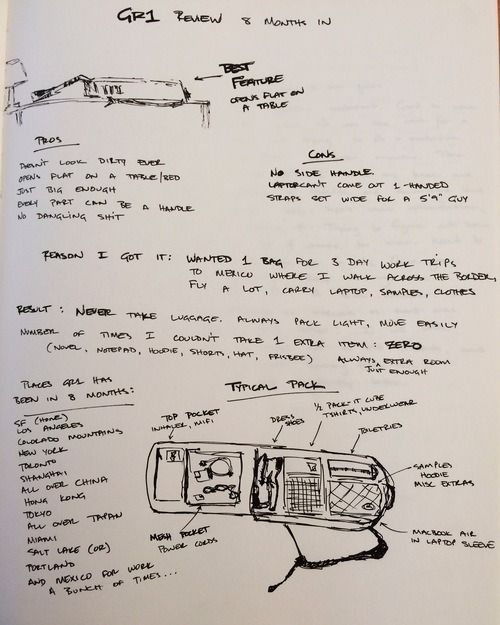For the past few years I’ve been packing ever less and traveling ever more. In this new life travel comes down to three things: what you need, what you have, and how annoyed by lugging it around you are. The challenge lies in minimizing the last while equalizing the first two. The key to all three of course is to minimize the first, need, which makes the resulting jenga algebra easier.
This review is about one way to do all three.
Duffels have made a comeback the past few years, often in the guise of a weekender. The premise is simple: a bag to hold some stuff for a short trip that doesn’t require much carrying. This means no hiking, though some duffels have backpack straps. This means no wheels. And, most essentially for the category, this means not much bag structure.
The poorly named Patagonia Stormfront Roll Top Boat Bag 47L focuses on this last element. The entire bag consists of a TPU (thermoplastic polyurethane) coated nylon that is cut and welded into shape. The handles, shoulder strap attachment points, zipper pocket, and carry loops are all welded on. This is a common construction in the boat/wet outdoor market, and all the bags in the Stormfront line feature the same base materials. Sea Line also makes a great line of bags using similar styling and a wider range of colors.
The Roll Top Boat Bag (hereafter boat bag to save words) is unique to this line in both size (47 liters) and lack of structure. When empty it can be folded or squished completely flat. There is a stiff plastic plate at the bottom, which is very useful to keep some shape when packing, but can be removed as needed. There are two simple mesh zip pockets internal and one external. There are two loops for attaching sandals, towels, hats, or jackets that were probably intended for more specific fishing gear. And that’s it. Empty, the bag folds almost flat, and is incredibly easy to stow in a closet, a major benefit in small apartments.
The best feature of this bag is also it’s great weakness: the roll top. The roll top provides a simple, waterproof, and variable size closure system. The last part is the key. Open, this bag becomes a holding cube, able to contain and hide huge amounts of gear. It is ideal when staying somewhere for a few days, as it can be opened up and used as a staging area, like a set of drawers, for all one’s belongings. Better than a small suitcase in this regard. Two of us have operated out of one for a week, without much re-packing during that time. It’s cavernous when fully expanded, as the pictures on Patagonia’s site demonstrate.
Needless to say this style of bag requires pack-it cubes. The specific style doesn’t matter, but in a bag without structure, items need to be grouped to prevent everything becoming a stew at the bottom of the bag. And that stew headlines the second part of this review, the problems with this kind of bag structure. First, roll top bags require a lengthy opening. Especially in the minimal style of the Stormfront, which features only one tiny exterior pocket, this means every interaction requires unclipping and unrolling the entire bag. This wouldn’t be such a burden if not for the second problem, unique to roll top duffels: shouldering it causes the closure to shift and gradually work it’s way open. This happens because when carried by the shoulder strap the two ends of the strap exert compressing pressure from the bag’s ends, which crunches it to the middle. The result is that the flat roll top becomes arched, and is no longer held flat and tight across the bag. Under this pressure
the rolled portion, without something to secure it in the middle, will gradually work its way open. This is especially problematic when moving quickly while carrying the bag on one shoulder, but happens over time regardless of position or speed. Also, because the TPU coating on the Stormfront is quite slick, it loosens especially easily. Without some kind of anchor or strap though, I believe any roll top bag of this size will open eventually. On the Stormfront it means carrying the bag is an exercise in rearranging, as the top will gradually shift, which allows the contents to move. Without pack-it cubes, the entire bag becomes a stew of items. With them, it retains the structure of the cubes’ exterior, but slides uncomfortably on the back.
Thus, after a lot of use, this is an excellent bag at the destination, but a difficult bag to carry to one. If transit involves primarily driving, boating, or short airplane rides where it doesn’t need to be checked, this is an excellent bag. The light weight, collapsibility, and cavernous interior are strong recommendations. Given the lengthy name, this is precisely the market Patagonia is targeting, and probably a correct one. Unfortunately the roll top that gives it such amazing storage when open is incredibly finicky when closed, and requires patience to carry for any length of time. This makes the bag much less useful for long walks or active sports, which are my primary use cases. The rather poor shoulder strap on the boat bag does not help, as it is thin and shifts around during use.
Overall this is a very well-built bag for specific uses, and we love it for short flights or weekend trips to friends’ houses.
Unfortunately the shifting and uncomfortable experience of carrying this bag for several hours has soured me somewhat on roll top duffels, and so I avoid all thought of more expensive ones like this seemingly awesome Outlier bag. I’d love to hear from other folk who carry roll top duffels, especially on a shoulder for any length of time.
